Australia So Much to See


Albany - Oyster Harbour and the lower Kalgan River
Having booked a morning aboard the Kalgan Queen, we first saw the statue of Sam the Seal at the marina, and learnt his story.
Sam the New Zealand Fur Seal, who over the years has trusted and befriended thousands of locals and tourists who visited him at Emu Point, was senselessly slaughtered by a coward who killed him in his sleep an act of ultimate betrayal in February 2006. Samís death was covered by national and international media and even drew comment from the Prime Minister.
A memorial service and scattering of Samís ashes attracted a crowd of 450 people. An appeal conducted by local riverboat operator Jonathan Jones has seen 2000 donors contribute to a life sized bronze memorial being erected at The Jim McIlvenie Park, Emu Point Boat Pens. Local sculptor and foundry man Jean-Jacques Kurandy made the statue in Albany and contributed around $20,000 of his own money towards the project.
Before the Kalgan Queen left the marina, Captain Jack introduced us to the pelicans which approached the boat. A favourite is Percy, who dances. She does pirouettes by spinning around on the spot in the water. Percy then came on board and Jack gave her a fish, which she turned in her beak so it was facing head first for a smooth swallow.
On departure, Jack took the boat to the heads of this shallow harbour where a navigable channel little more than 100 metres wide goes between Emu Point and the Gull Rock Nature Reserve.
Sam the Seal
Now a legend who
befriended all people to
be betrayed by one
Compiled from Albany Australia and ABC news.
Visit the memorial and experience how Sam affected so many. A plaque on the memorial reads
Our Captain Jack showed us that most of Oyster Harbour is very shallow and almost scraping the bottom of the flat based boat, but there are two deep channels near edges of the harbour, formed by the ancient Kalgan River before the harbour area became flooded. Much of the harbour is only one foot deep with channels 35 to 40 feet deep. The Kalgan River is believed to be the oldest river in the World.
The warm shallow environment creates and ideal place for oysters and the abundance can be seen through the glass bottom of the Kalgan Queen.
A trial oyster farm was established in 1947 in the middle and northern part of Oyster Harbour, near the mouth of the King River. Pacific oysters introduced from Japan were used but the venture was not successful. By the end of the winter of 1948 the oysters had died out.
There was no further activity until 1991 when Ocean Foods was granted a fish farm license by the Western Australian Fisheries Department (now called Fisheries Western Australia) to farm mussels and oysters. The company established its operations in Oyster Harbour growing blue mussels (Mytilus edulis) and the belon (Ostrea angasi) and rock oyster (Saccostrea commercialis). The company is also looking at the production of the arkshell clam (Anadara trapezia)
Mussells are successfully farmed in the harbour, settling on ropes strung between drums used at floats as seen in the right hand side photo.
We watched an Osprey catch fish thrown from the boats, but the Pelicans were often too quick with the catch. The pelican gets the fish in the first photo.
Extract from Rivercare South Coast WA
The Osprey (Pandion haliaetus), also known as the sea hawk, fish eagle, river hawk or fish hawk, is a diurnal, fish eating bird of prey. It is a large raptor, reaching more than 60 centimetres in length and 180 centimetres wingspan. It is brown on the upperparts and predominantly greyish on the head and underparts.
This giant sized statue of a Kingfisher (centre picture) overlooks the Kalgan River and can be reached on foot when taking the riverside Luke Pen walk from the Lower Kalgan Bridge. Dr. Luke J Pen 1960-2002 was a biologist and environmental scientist in South Western Australia. He researched and wrote about rivers and their biology and management. See A Brief History of the Kalgan Area
The White-bellied Sea Eagle (Haliaeetus leucogaster), also known as the White-breasted Sea Eagle, is a large diurnal bird of prey. The adult White-bellied Sea Eagle has a white head, breast, under wing coverts and tail. The upper parts are grey and the black under-wing flight feathers contrast with the white coverts. The tail is short and wedge-shaped as in all Haliaeetus species. Like many raptors, the female is slightly larger than the male, and can measure up to 90 centimetres long with a wingspan of up to 2.2 metres, and weigh up to 4.5 kilogrammes. Immature birds have brown plumage, which is gradually replaced by white until the age of five or six years.
We travelled on a tidal section of the Kalgan River, which extends to a rock bar near the Upper Kalgan Bridge. Our turn around point was at Montgomery's Hill Wines with wine tasting and cellar sales.
On the return down the river, Jack served us mugs of tea and coffee together with hot damper, home made to the familyís special recipe which is available on the Kalgan Queen website.
This river is believed to be the oldest river in the World. First named by the French explorer Nicolas Baudin in 1803 "The Riviere des Francais" was commonly referred to as The French River.
Jack told us of how in 1830 the river was renamed "The Kalget River". Kalgets were frogs hunted by Aboriginals on the river, so they were taking the Mickey out of the French by calling it the "Frog River" and at some stage it was written down incorrectly hence, "The Kalgan River".
However the name goes back far into the past.
In 1831 Alexander Collie, the first Resident Magistrate of Albany, wrote that the aborigines of King George Sound had two names for the river that ran into the north east of Oyster Harbour. Collie, a close friend of the Aboriginal leader, Mokare, wrote that aborigines called the river Kalganup (believed to mean place of fish, though also recorded as place of many waters) and Yamungup (the meaning of which is not known).
Percy the pirouetting pelican met the Kalgan Queen soon after our re-entry into Oyster Harbour, then bade us farewell.
Dr. Alexander Collie recorded the river as 'Kal-gan-up' in April 1831, and it was named The Kalgan River later that year.
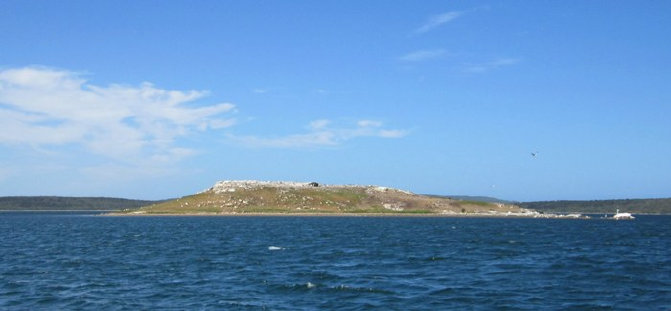
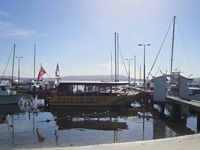
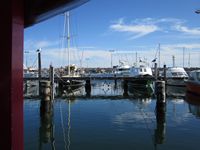
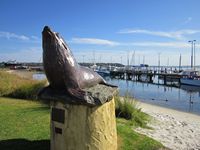
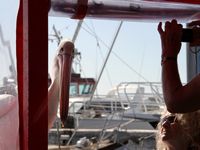
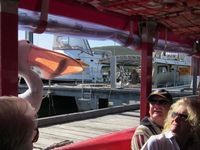
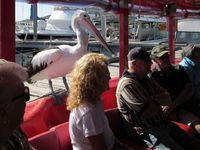
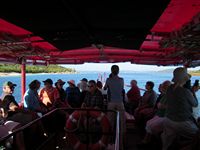
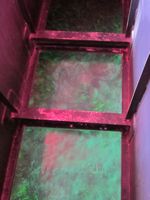
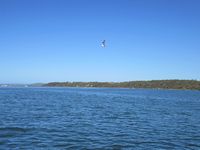
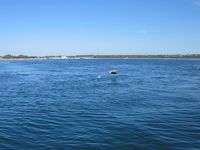
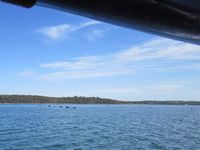
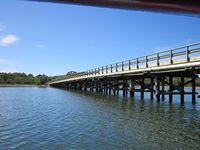
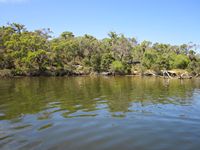
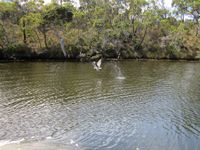
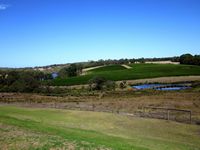
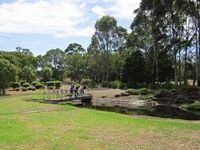
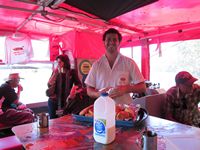
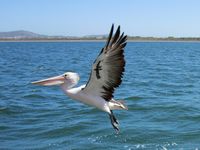
Captain Jack told us the history of oyster farming in Oyster Harbour and at Emu Point. Due to viral infections, early attempts at oyster farming failed. This included bringing stock in from Carnarvon which had some resistance to the virus. After early failures, the Emu Point Oyster farm is now thriving, with a retail shop as well as building up significant export markets of Sydney Rock oysters, including to Asia and Dubai.
The shallow waters of Oyster Harbour are ideal for farming mussels and oysters with nutrients washed in by the Kalgan and King rivers.
Green Island is a small island in Oyster Harbour covering an area of two hectares.
This island is one of only four permanent Pelican breeding grounds in Western Australia; the others being Mandurah, Rockingham and Shark Bay. Green Island was declared a nature reserve in 1988.
Being rich in guano, Green Island selected as ideal to grow vegetables for the early Albany settlement. By 1830 a vegetable garden was underway, tended by a convict gardener who dwelt in a hut on the island.